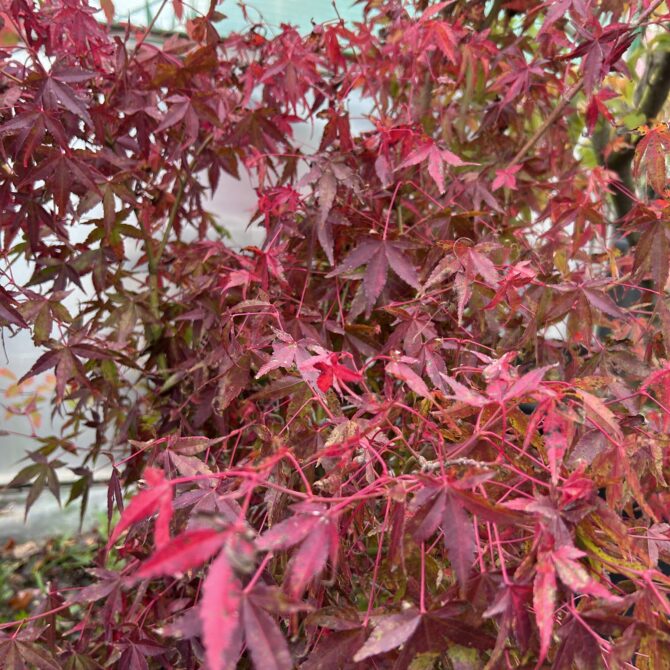In the wild most Japanese maples grow on the fringes of woodland, out of strong winds, with some light shade and grow best in acid to neutral soil. They do best of all in moist but free-draining soil and also make great pot plants. There are many varieties of Japanese maples, some are more wind tolerant than others, some will take full sun but most enjoy light shade at the hottest part of the day. Acer palmatum dissectum cultivars as a group are less tolerant to windy conditions. Staking the central leader for two or three years so that the other branches are able to cascade from a height should help their weeping habit. It is worth bearing these points in mind when selecting the final position.
All Japanese maples should be planted with care. They can live to well over one hundred years, so it is worth taking some care in selecting and planting your tree. Preparation and planting is straightforward:
- Dig a hole at least twice as wide and a little deeper than the root ball. Break up the bottom of the hole and add a 50mm or 2 inch layer of planting compost and grit mixture and chop into the bottom of the hole.
- Carefully remove the plant from the pot. If it is any way dry, water it before planting; ideally by soaking in a bucket of water until all of the air bubbles have disappeared.
- The surface of the root ball should be about 25mm or 1 inch below the soil surface. Mix the soil you have removed from the hole half and half with the same planting compost and grit mixture and use it to fill in around the root ball.
- Water well. There is no need to add fertiliser as Japanese maples do well on low nutrient levels.
- Finish the job with a bark mulch and keep it moist but not waterlogged through the first growing season.
Planting your Japanese Maple
All Japanese maples should be planted with care. They can live to well over one hundred years, so it is worth taking some care in selecting and planting your tree. Preparation and planting is straightforward:
- Dig a hole at least twice as wide and a little deeper than the root ball. Break up the bottom of the hole and add a 50mm or 2 inch layer of planting compost and grit mixture and chop into the bottom of the hole.
- Carefully remove the plant from the pot. If it is any way dry, water it before planting; ideally by soaking in a bucket of water until all of the air bubbles have disappeared.
- The surface of the root ball should be about 25mm or 1 inch below the soil surface. Mix the soil you have removed from the hole half and half with the same planting compost and grit mixture and use it to fill in around the root ball.
- Water well. There is no need to add fertiliser as Japanese maples do well on low nutrient levels.
- Finish the job with a bark mulch and keep it moist but not waterlogged through the first growing season.
Growing your Japanese Maple in a container
Many Japanese maples do very well in containers or pots placed on a patio amongst other plants and with correct feeding and watering, can live happily in a pot for many years. To pot up your maple:
- Use a pot no more than twice the size of the pot the plant is bought in, do not over-pot. Use a good quality multi-purpose compost and add 10% grit to this; or alternatively use John Innes No.3.
- Top up each spring with a small amount of slow release fertiliser. Make sure the pot has good drainage holes and stand the pot on feet or tiles to allow free drainage through the bottom of the pot.
- Remember to keep container grown plants well watered when they are in full leaf. Do not rely on the rain as most of the water will be shed away from the pot by the tree?s leaf canopy.
- If you wish to prune your Japanese maple do any heavy pruning in January to February. Light trimming may be done in the summer.
For any further information about your Japanese Maple, please either call us on 01903 891466 or email us at info@bigplantnursery.co.uk and we will be glad to help.



